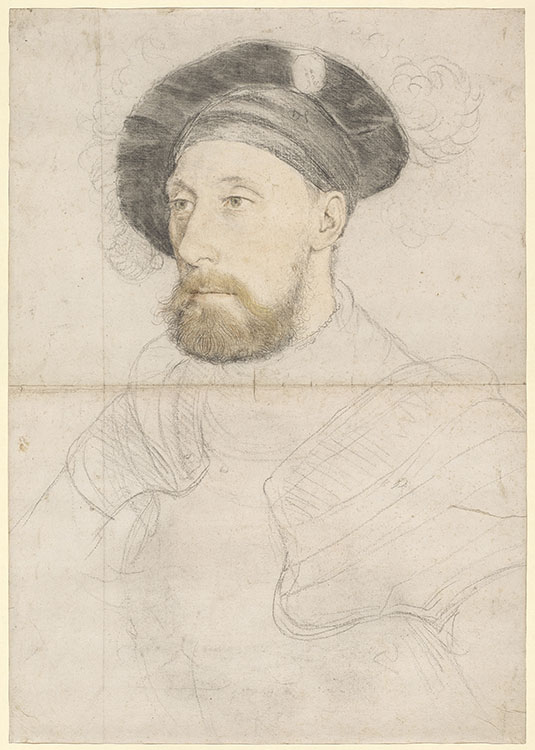
Sir Nicholas Carew (ca. 1496–1539) carried out several important diplomatic missions in the service of Henry VIII. Made with a painted portrait in mind, this study exemplifies Holbein’s approach to drawing during his first stay in England. Working on a large scale and concentrating his attention on Carew’s face and beard, the artist modeled the man’s features by carefully blending black and colored chalks. Other parts of the drawing, such as the sitter’s upper body and the fluffy feathers that adorn his hat, are described using swiftly drawn yet virtuosic lines. The headgear is covered entirely in black chalk, but the letters gl, inscribed on the headband, would have reminded Holbein that the garment’s actual color was either yellow (gelb) or gold (gold).
Hans Holbein the Younger (1497/98–1543)
Sir Nicholas Carew, 1527
Black and colored chalks
Kunstmuseum Basel, Kupferstichkabinett, Amerbach-Kabinett 1662; 1662.34
Before 1539—when he was accused of participating in a conspiracy to overthrow King Henry VIII and beheaded at Tower Hill—Nicholas Carew enjoyed a very successful career as a courtier and diplomat. He was one of the king’s closest associates and undertook a number of important diplomatic missions, even accompanying Henry to his famous meeting with the French King Francis I at the Field of the Cloth of Gold in 1520.
This large, brilliantly preserved drawing focuses on Carew’s physiognomy and luscious beard. It belongs to a small group of portrait studies in colored chalks, which Holbein produced during his first stay in England. Although the artist had begun experimenting with the medium only a few years prior, the skillful blending of different colors attest to his great mastery. Carew’s skin is modeled using a combination of red and black chalks, achieving an almost three-dimensional appearance. The armor and the opulent feathers that adorn his hat, on the other hand, are done more swiftly, with the greatest economy of means.
Kunstmuseum Basel Martin P. Bühler
